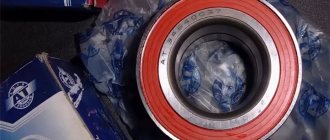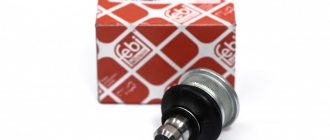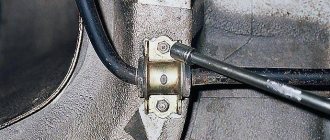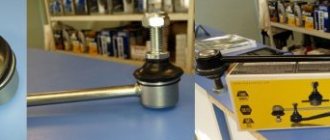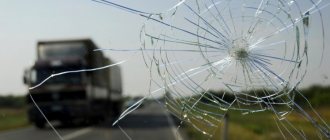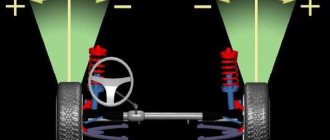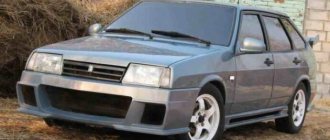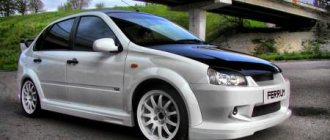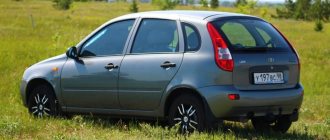Stabilizers are responsible for the vehicle's stability on the road. To eliminate noise and vibration from the operation of the components of the stabilizers, special bushings are used - elastic elements that give smooth operation.
What is a bushing? An elastic part is created by casting from rubber or polyurethane. Its shape remains virtually unchanged for different car models, but sometimes has some features depending on the design of the stabilizer. To improve the performance of bushings, they sometimes have bosses and grooves. They strengthen the structure and allow parts to last longer, and also protect against mechanical stress that can damage them.
Stabilizer bushings. Signs of malfunction. Consequences.
For the best damping of vibration and force impacts on the car body, the vast majority of suspension elements are connected by means of elastic elements.
The same applies to the stabilizer. To secure it, special bushings (rubber bands, cushions) made of durable rubber or polyurethane are used. Over time, as the vehicle is used, these bushings may begin to deteriorate and noticeably lose their elasticity. The result of this is unsatisfactory operation of the stabilizer =. More serious defects may begin to appear, which will only grow faster over time. The first symptom indicating replacement of the bushings will be a slight knocking sound from the suspension. A similar knock can be observed with “tired” shock absorbers. Only in the case of bushings it will be heard not only on potholes and potholes, but also when entering relatively sharp turns. At the same time, the car often feels excessively rolly and sluggish. The knocking sound that appears will be a consequence of play that has arisen in the connecting nodes of the stabilizer arms due to worn bushings.
If measures are not taken in time, the knocking will only intensify in the future and will begin to accompany the operation of the suspension everywhere due to increasing deformation and destruction of the bushings. Body roll and excessive play in the steering wheel may occur. The car may “yaw” not only when turning, but also when braking or changing lanes. Most car manufacturers recommend changing stabilizer bushings every 30–40 thousand mileage. However, in our conditions it is better to focus on bushing wear. Therefore, a sudden knocking sound and slight rattling in corners will be clear signs of an impending component replacement.
As a popular method of checking the bushings for serviceability, it is proposed to drive the speed bump diagonally in 2nd gear. A dull knock appeared in the area of the pedals - most likely due to the hub bushings. You can also just crawl under the car and inspect everything yourself. A worn bushing will be pleased with the presence of cracks and abrasions characteristic of worn and cracked rubber. Auto mechanics sometimes also call these cracks “daisies.”
Also, the rubber of the bushings can simply harden and lose the necessary elasticity. If you can’t get a good look at the stabilizer bushings, just swing your hand strongly up and down and to the sides on the stabilizer itself. If you feel play, creaks and knocks in the lower part of the suspension, it means that the bushings have become unusable.
But for the best results, it is, of course, better to drive onto an overpass, an inspection hole, or use a lift. The only tools you will need are a crowbar or a mounting spade, which you simply need to rest against the bottom of the car and slightly “shake” the stabilizer where it connects to the body. If you feel noticeable play or loss of elasticity, then it’s time to think about replacing the bushings.
Anti-roll bar
But there is one more important detail in the suspension, without which no modern car can do. And this part is a stabilizer. It can be easily seen if the car is driven onto a lift or placed on a viewing hole. On the front axle, among the springs, shock absorbers and other levers, you will easily notice a curved steel rod, which is attached to the subframe with one arm and to the wheel hub with the other. The stabilizer mounts are not rigid and allow it to move along the axis in one plane.
The stabilizer appeared in the suspension design at the dawn of the automotive industry, when speeds began to reach 20 km/h and above. The introduction of this element into the suspension design made it possible to ensure that the vehicle remains stable when cornering and maneuvering.
Thus, the main task of the stabilizer during movement is to distribute the weight of the car body over all its wheels in the event of a roll. In particular, this applies to cases of fairly sharp turns or when there is a sudden change in the trajectory of movement.
The principle of operation of the anti-roll bar
On the McFerson type of suspension, which is quite common today, the stabilizer is a torsion bar that acts on torsion. This element is rigidly connected to the car body or subframe. The forces generated in the suspension are transmitted to the stabilizer through additional levers, which communicate with the suspension through hinges. This simple scheme allows you to prevent even a serious roll of the vehicle, and even more so, its rollover.
The rear axle is most often equipped with a stabilizer of this type if the vehicle has all-wheel drive. If we talk about cars with rear-wheel drive and a solid beam on the rear axle, then the role of the stabilizer is given to the reaction bar, also known as the Panhard rod.
Also, a number of Japanese off-road vehicles at one time, in addition to the Panhard rod, were additionally equipped with another stabilizer, which, in the form of a curved rod, ran along the rear axle beam and communicated with the power components of the body through small levers.
Benefits of timely replacement
Every driver can cope with replacing bushings on his car, because this process is not a very complicated repair. You can do everything yourself, but if you don’t have the time or desire, then it is advisable to seek help from specialists. This will protect the stabilizer bar links from premature wear.
Driving on poor-quality road surfaces will fade into the background if you have previously installed new bushings. And in general, installed new bushings mean the absence of difficulties and problems when moving, as well as comfort and safety.
Tool
To replace the front or rear bushings yourself you will need:
- small ratchet with extension and socket head;
- open-end wrench, it should be thin and small;
- large ratchet, universal joint adapter and socket head;
- You may need an L-shaped extension.
Replacing the Kia stabilizer bushing
Replacing the Kia stabilizer bushings involves the following algorithm: • Raise the front of the car and remove the wheels. Find the steering shaft and make a mark (for easy further installation in the original place), remove the mounting bolt. • Using a jack, lift the gearbox, unscrew the rear cushion and subframe. • To simplify access to the rear cushions, four bolts are removed to secure the subframe. • Raise the front part of the subframe using a jack. • Remove the fastening and treat it with an oil solution to prevent the development of corrosion processes on the metal. • Screw them into place only four to five turns.
This is done crosswise to provide additional security and uniform tightening of the plane. • Loosen the jack to a level where you can reach the bushing bolts. • The bushing on the right side can be easily unscrewed through the engine compartment, and on the left side - from below. • Insert staples. This procedure is carried out in a careful manner so as not to damage the clamp on the steering boot. • The process is repeated in reverse order. The peculiarity of the Kia Sid car is that the steering shaft has a telescopic appearance, and therefore its installation occurs at the last moment.
Advantages and disadvantages of SPU
Given the obvious simplicity of the design of the mechanism we are interested in (you only need a reliable support for its fastening, high-quality rubber bushings, rods, bones), it easily copes with the tasks assigned to it. But here it is worth saying that SPU reduces the travel of the independent suspension and “takes away” some other important properties from it. For this reason, the installation of a stabilizer bar is not carried out on off-road vehicles.
When driving such all-terrain vehicles equipped with off-road tires on bad roads, the wheel loses contact with the road and hangs up. And this negative phenomenon is caused precisely by the use of SPU. It is clear that car designers are not going to abandon the use of stabilizers in these cases either. Several options have now been developed to improve the design of SPUs intended for off-road vehicles.
For example, she created a modern system consisting of hydraulic cylinders that act as struts, a lateral acceleration sensor, a hydraulic pump and a special control unit. This system, which does not require rubber bushings, has proven itself to be an effective replacement for traditional SPU.
Also, Western automakers began to actively install adaptive suspensions on their cars. These mechanisms make it possible to completely abandon the control system, guaranteeing ideal behavior of the vehicle (without rolls) in any driving conditions (when accelerating, turning, hard braking, and so on).
The following types of bushings exist:
1. Spherical (or “iron”) bushing. The design resembles a ball joint;
2. Rubber bushing.
Today, polyurethane type stabilizer bushings are becoming increasingly popular. They are quite easy to replace, which is an important advantage, and they also have good operating characteristics. Experienced drivers can safely say that these are the parts that are most convenient.
If a malfunction occurs in the area of the stabilizer bushing , it must be replaced without fail. Otherwise, this can have a very bad effect on the performance and handling of the vehicle. When the bushing is deformed or cracks appear on it, some noise may appear in the area of the car suspension (mainly when the car hits an obstacle or increases speed). In principle, problems in the suspension area are identified precisely by such noise.
In order to make sure that it is necessary to replace the bushings, periodically it is necessary to carry out diagnostics of the suspension, after which the malfunction will be identified or prevented.
In the event that it is determined that it is necessary to replace the stabilizer bushing, this can be done independently. Moreover, there is nothing complicated about it and the procedure is very simple. First, the bolts with which the clamp is attached are unscrewed. Then the stabilizer is moved to the side and the old parts are removed. Well, for the final action, the new part is installed very carefully.
It is according to this scheme that both the front stabilizer and the rear stabilizer are replaced . After replacing spare parts, driving a car will be much more pleasant and comfortable, and various kinds of road obstacles will be overcome without any difficulties. Among other things, the new elements will maximize the performance of the racks.
Throttle sensor: purpose, types, types, malfunctions, photos
Idle speed sensor: principle of operation, device, types, photo, purpose
Air flow sensor: principle of operation, types, malfunctions, photos
Let's sum it up
As you can see, the rear stabilizer bushing or the front stabilizer bushing is a simple element both in terms of design and replacement. At the same time, the bushing of the stabilizer link and the bushing of the stabilizer itself are different, so it is important not to confuse these elements when selecting the necessary spare parts.
The vehicle suspension is one of the most important parts, subject to heavy loads and taking on all the impacts of a rough road. Thanks to its operation, the driver can feel comfortable and not be afraid that while driving the situation may get out of control. However, due to heavy loads, especially when driving on bad roads, which is not uncommon in the Russian Federation, its parts often fail. The most common problem is broken stabilizer bushings. Let's take a closer look at why this happens and how the stabilizer bushings are replaced.

